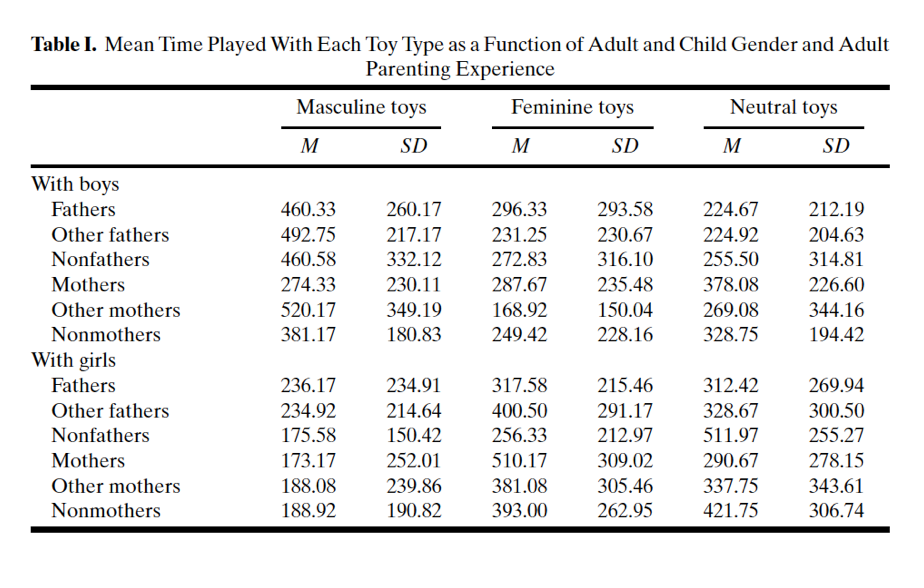Wood (2002)
 The following study was carried out by Wood, Desmarais and Gugla (2002).
The following study was carried out by Wood, Desmarais and Gugla (2002).
The study may be used to discuss enculturation of gender roles (sociocultural approach) or the development of social roles (developmental option).
The original study may be accessed here.
The purpose of this study was to examine gender role enculturation as a result of parenting and toy selection. This study is a modern variation of Fagot’s (1978) and Smith & Lloyd’s (1978) studies. A sample of 48 children (24 boys and 24 girls, age 24 - 72 months) played with either his or her own mother or father, a mother or father of another child, and a man or woman who was not a parent. The adults were matched for age, educational level and occupation.
The children had a one-on-one play session with an adult at the child’s preschool or home. There were three play sessions in total for each child. Half of the girls played with their mother, other mother or non-mother; the other half played with their father, other father or non-father. The boys were the same. Each play session lasted fifteen minutes.
15 toys were arranged in a straight line in the room - with five stereotypically boy toys (e.g. a dump truck, a basketball, a Fisher Price gas station), five stereotypically girl toys (e.g. a kitchen set, a baby doll and a doll house) and five gender neutral toys (blocks, a stuffed teddy bear and PlayDoh.)
During the play session, the amount of time children and adults played with gender-specific toys was recorded. After the session, the adults were given a “gender sorting task” in which they were asked to categorize each toy as a masculine, feminine or neutral toy.
The results of the observation are in the table below.

The gender-sorting task showed that adults did not agree with traditional “expert” categorizations of some of the toys, which suggests a shift in the perceived function of some traditionally stereotyped toys. However, regardless of how parents sorted toys into categories, when playing with boys, most time was spent with masculine toys. With girls, on the other hand, there was greater flexibility in the categories of toys with which they played.
The study is a quasi experiment that makes use of a naturalistic observation of children in their own home; the study high ecological validity.
As it is a standardized observation, it may also be replicated, allowing others to test the reliability of the findings.
As it is a naturalistic observation, there is a lack of control over confounding variables in the study, although there have been some attempts to control for the age/education of the adults who were not parents of the children.
The fact that the parents and children know that they are being observed may have an effect on their behaviour.
It is believed that children develop gender role identities by age 4. These children are all younger so should not already have predefined preferences for certain "gendered" toys.
The study is a modern replication of research such as Fagot (1978) and Condry and Condry (1976). This study challenges the temporal validity of these older studies.
The study was done in McMurdo - so there is a WEIRD sampling bias (Western, Educated, Industrialized, Rich, Developed country). It may be difficult to generalize the findings to other cultures.

 IB Docs (2) Team
IB Docs (2) Team
